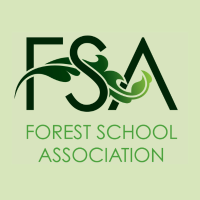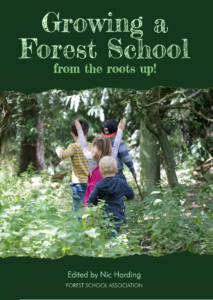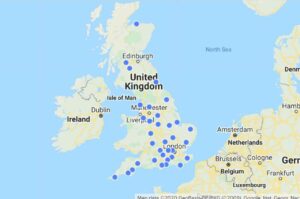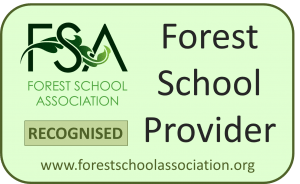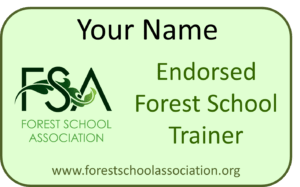Guidance for qualified Forest School Leaders relating to Tree Safety and Woodland Health at Forest School.
“Safety is but one of the many goals to which we aspire; the mistake that is often made is to focus on safety as if it is the only goal.”
Professor David Ball
Centre for Decision Analysis and Risk Management – Middlesex University
Disclaimer: The information provided in this article, the Forest School Association’s guidance on Tree Safety and Woodland Health, is intended for general informational purposes only. It is not intended as legal, safety or professional advice. Forest School leaders and other individuals should use their discretion and seek professional advice where necessary. The Forest School Association accepts no liability for any actions taken based on the information provided in this guidance document.
Introduction
The lack of understanding of our woodlands coupled with a risk averse culture, especially prevalent in school settings, has resulted in drastic management decisions and restricted access on purported safety grounds.
This document aims to help us understand the issues surrounding tree safety and reach a balanced conclusion: one that ensures that our trees and woodlands, essential for the ecosystem, public health and the common good can thrive in the UK without being compromised by unnecessary safety management or damage.
What does the data tell us?
Data shows that tree hazards present a very low risk to human safety. Though tragic for anyone involved, very few people are killed by trees. In the UK, on average, falling trees or branches kill only six people annually. In a population of 60 million, this means a one in 10 million chance of dying from a falling tree, or a one in 20 million chance of being killed by a tree in a public open space. The Health and Safety Executive (HSE) recognises that the risk of “being struck and killed by a tree falling” is “extremely low” which is why it sits firmly in its “broadly acceptable“ category of risks.
There are reasons why so few people are killed by trees; these include trees failing in storms when fewer people are out and about, more frequent inspection and management of our trees, improved knowledge and understanding of trees among landowners, leaders and the public, and the reduced likelihood of people being in woodlands during storms.
Disproportionate media attention, especially after storms when trees fall, creates a public misconception of excessive danger. When asked individually, most people’s perceptions are more realistic. However, because trees so rarely kill or seriously injure people, when they do, it is headline news. The number of people killed by cars, being 500 times more likely, is so commonplace that the deaths barely get a mention. Sadly, these headline stories about deaths caused by trees have made landowners increasingly and disproportionately concerned about the risks presented by trees on their land and their resulting liabilities if something goes wrong.
What are the legal requirements?
- Under civil and criminal law, an owner of land on which a tree stands has responsibilities for the health and safety of those on or near the land and potential liabilities arising from a tree or branch falling.
Therefore, the landowner must take reasonable care to avoid acts or omissions that cause a reasonably foreseeable risk of injury to persons or property.
In the context of tree safety, this duty of care would be to consider the risks posed by their trees, the need to evaluate their own level of knowledge and the critical inspection standards for trees. At this point, we need to take a risk benefit approach to the balance between the risk posed by trees in general terms, the amenity or other value of trees, and the cost of different types of inspection and remedial measures, in the same way that we apply a risk-benefit approach to our provision.
- There is no legal inspection standard and no clear or unambiguous indication from the courts regarding the extent of the knowledge about trees a landowner is expected to bring to tree inspection regarding the type and regularity of inspection. It should be noted that the HSE states
“for trees in a frequently visited zone, a system for periodic, proactive checks is appropriate”.
As Forest School leaders, we already have a system for periodic and proactive safety checks; we will all undertake daily and seasonal site checks, site risk benefit assessments, which, when recorded, form part of atree inspection system.
The Inspection Process: What are we looking for?
Tree Health and Biosecurity. Numerous resources can guide us in this, but we are looking for signs of ill health or damage in the tree, which could indicate instability in standing or overhanging wood, especially after significant weather events that may exacerbate problems and accelerate deterioration. We are also looking for any bleeds, rot cankers, or fungus that may indicate rot, holes, and breaks in bark, especially around branch junctions, wilting and dieback. It is also worth noting where the tree is and when and how often the site is used.
We must take care when introducing new plants or trees into our sites, ensuring they are from reputable sources, disease-free and will not bring pathogens or invasive species into the woodland. Cleaning our boots, tools and equipment used regularly and avoiding moving material from one woodland to another is an easy way to reduce the risk of spreading pests and diseases.
Zones of Use. Viewing your site in terms of “Zones of Use” may help with any management decisions you need to make in the future. Zones of high use could be play areas, swings, fire pits, etc. Access paths may have less frequent use and some areas may not be accessible or frequently used; we may be able to block access where a tree has significant damage, leaving it to become standing deadwood – not all damaged trees require removal.
When do we need a formal tree inspection?
The maturity and species of the trees will determine the level and frequency of inspection on your site. A professional should carry out an initial formal inspection of a woodland to be used for Forest School sessions. This will help you understand your site better and decide on the regularity of formal inspection. An immature woodland may not require regular formal inspection and Forest School leaders with knowledge of sustainable woodland management may be experienced enough to carry out the work.
Depending on the nature of the site and age/ health of the tree cover, formal re-inspection is usually recommended every two to three years – or more frequently following outbreaks of disease, significant storms or prolonged drought. This formal inspection should then act as a baseline for informal/daily inspections by Forest School leaders who, realistically, are just looking for gross defects and obvious hazards.
Who can carry out a formal tree inspection?
There is no hard and fast guidance for who you employ to undertake the formal inspection. Your local authority may have a tree officer who will provide this service and/or advice; a trusted tree surgeon with knowledge of tree safety may do this, or you may contact the Arboricultural Association.
Whoever undertakes the formal inspections should be able to provide their qualifications, have public liability insurance, professional indemnity insurance for written reports and provide a written report with management recommendations. This benchmark survey will give a suggested timeframe for work and should identify groups/ individual trees (mapping/ photographs/ tags) to enable targeted management and monitoring.
The Forest Education Network England (FENE) recommends that a basic formal inspection be carried out by someone who has completed a Lantra introductory course or equivalent as a minimum requirement. A more detailed formal inspection may be needed in a mature canopy woodland, such as one carried out by an arboricultural professional with a Level 3 Lantra Professional Tree Inspection qualification.
Tree inspections may require management work such as removing deadwood and crown reduction. Trees may need to be removed in extremis. You should always be able to ask the person inspecting how they make their decisions.
Any tree surgeon employed to undertake the work should have insurance, the correct climbing certification, etc. You can also ask them to leave logs and branches for you and your groups to use. They will often work in situations where they must chip and remove all the branches and logs, so you may save them time and effort. Finding someone who understands woodland ecology, the properties of individual tree species, tree pests and diseases, biosecurity, and the value of standing deadwood is essential. Ensuring that they can balance this with risks for your group is also crucial.
To clarify this process, any significant work undertaken by tree surgeons should be initially inspected by a suitably qualified and experienced professional.
Conclusion
Ultimately, we are part of a sector trying to increase people’s time spent in woods and among trees. We will fulfil our legal obligations if we take consistent steps to know the health of our trees and understand the sites we work on.
We would like to thank FENE colleagues, the foresters and arborists for their time and expertise in helping us develop this guidance note.
For general advice on woodland ecosystems, tree health, risk and impact assessments:
Common Sense Risk Management of Trees, National Tree Safety Group Guidance on Trees & Public Safety for Owners, Managers and Advisors
FENE Resource Hub https://rfs.org.uk/fene/fene-resource-hub/fene-training-materials/
Yorkshire Arboretum Tree Health Centre https://www.yorkshirearboretum.org/treehealthresourcehub
For guidance on appropriate trees for setting up rope swings, https://www.visitorsafety.group/wp-content/uploads/2019/05/Tree_swings.pdf
For advice on tree consultants and tree surgeons – note: not all qualified and experienced professionals are registered on this trade association website.
Prepared by Sarah Lawfull, Chris Wishart and the team of FSA Endorsed Forest School Trainers – October 2024
